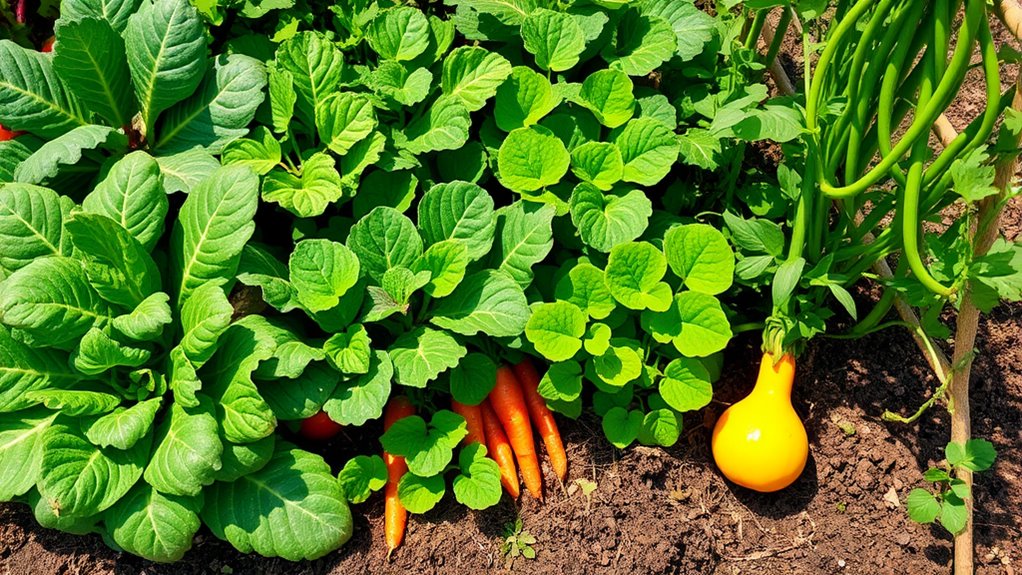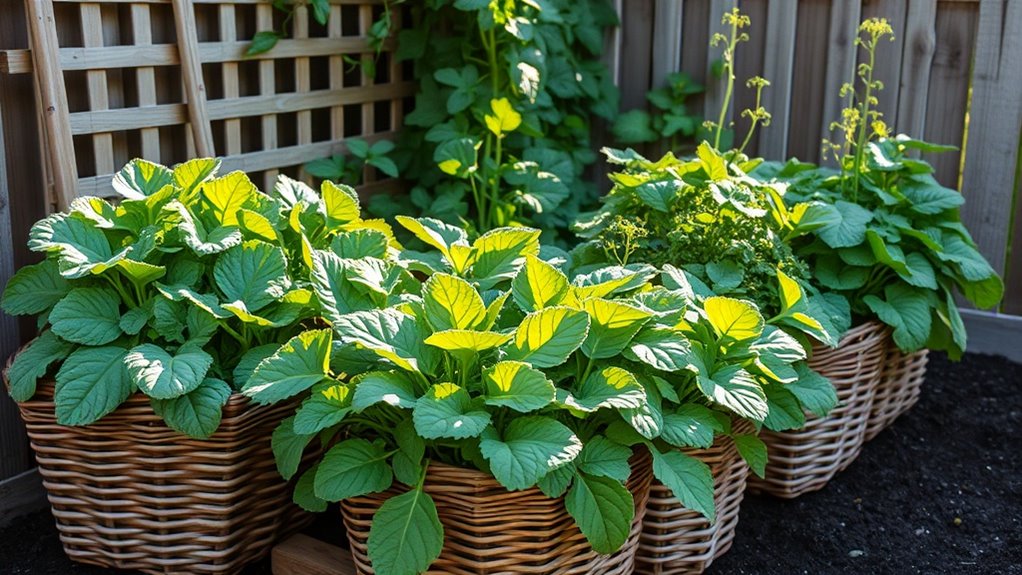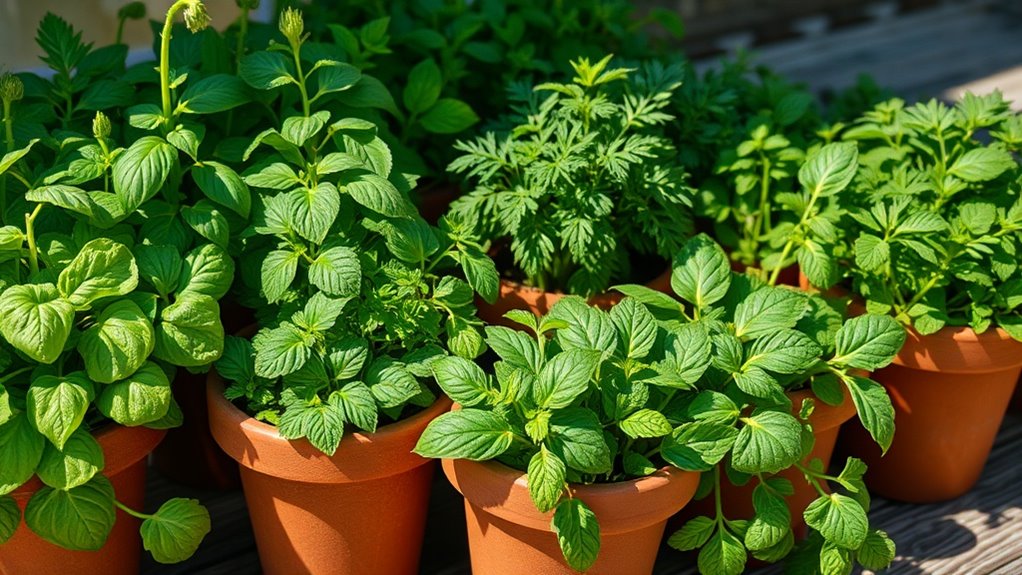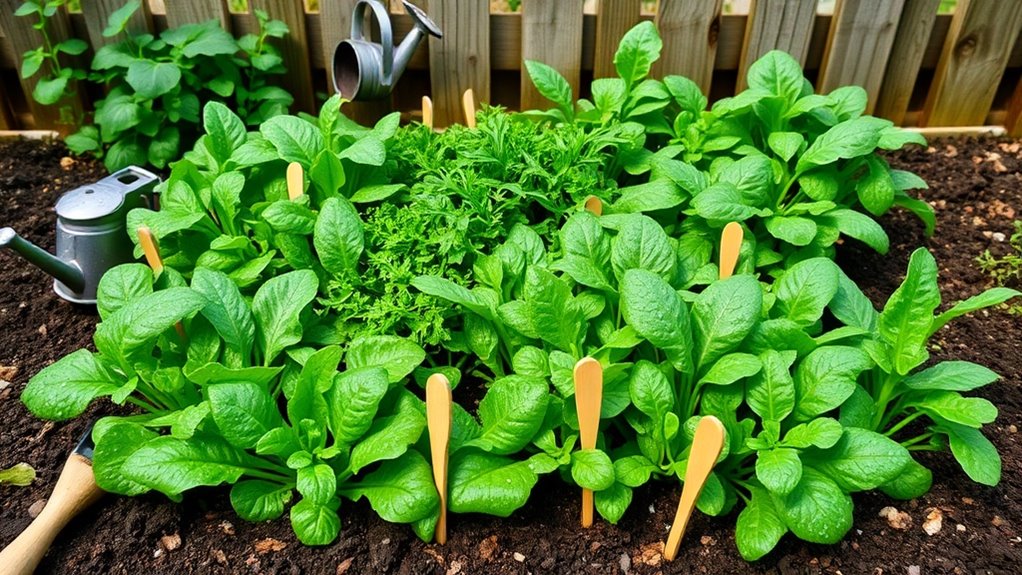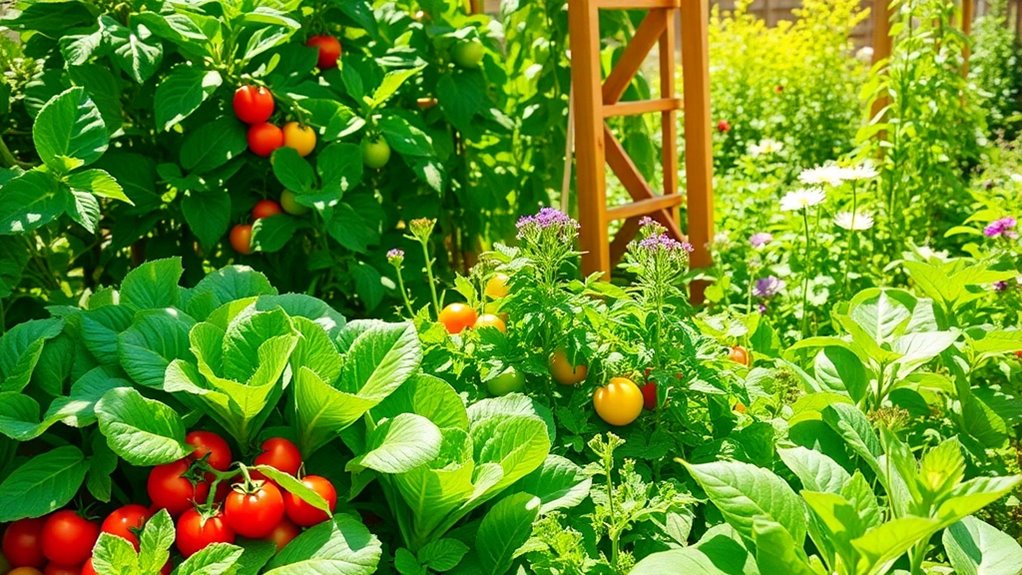7 Beginner Vegetables That Don’t Need Much Water
If you’re looking to start a garden that conserves water, you’ll want to focus on vegetables that thrive with minimal irrigation. Zucchini, kale, and radishes are just a few options that not only grow quickly but require less attention. Mulching can help retain soil moisture for others like Swiss chard and peppers. Curious about the best practices for each and how to maximize your gardening success with these easy-to-grow vegetables?
Key Takeaways
- Zucchini requires deep but infrequent watering, making it ideal for beginners looking to conserve water while enjoying prolific yields.
- Kale thrives with moderate water needs and is easy to grow, perfect for novice gardeners.
- Radishes are quick to mature and need watering only once a week, making them hassle-free for beginners.
- Peppers, including drought-tolerant varieties, require minimal water and are beginner-friendly with vibrant yields.
- Onions need little water overall and are easy to cultivate, providing a low-maintenance option for novice gardeners.
Zucchini
Zucchini, a versatile summer squash, thrives in gardens with minimal water needs. As one of the best drought-tolerant crops, it’s perfect for beginners who want to conserve water.
Plant zucchini in well-drained soil and ensure it receives full sunlight for optimal growth. Water it deeply but infrequently, allowing the soil to dry out between sessions. This encourages strong root development, making your plants more resilient to dry conditions. You’ll appreciate its rapid growth; within weeks, you’ll harvest tender, delicious zucchinis.
Incorporating zucchini into your garden not only saves water but also provides nutritious, versatile produce for your meals. Additionally, zucchini is known for its low water requirements, making it an excellent choice for sustainable gardening practices.
Kale
Kale, often hailed as a superfood, is a fantastic choice for beginner gardeners looking to minimize water usage. This leafy green thrives in cooler weather and requires less water than many other vegetables. Additionally, kale is known for being one of the easiest vegetables for novice gardeners to cultivate successfully.
| Feature | Details |
|---|---|
| Water Needs | Moderate |
| Planting Season | Early spring or fall |
| Harvest Time | 50-75 days after sowing |
Radishes
Radishes are one of the fastest-growing crops you can plant, making them perfect for beginners eager to see quick results.
They thrive with minimal water, allowing you to enjoy fresh, crisp radishes without the hassle of constant watering.
Plus, their simple cultivation process means you can easily incorporate them into your garden, regardless of your experience level. Additionally, radishes are known for their fast-growing nature, allowing you to harvest them in as little as three to four weeks after planting.
Fast Growing Crop
If you’re looking for a fast-growing crop to kickstart your garden, radishes are an excellent choice.
These vibrant veggies can mature in just 25 to 30 days, making them perfect for beginners eager for quick results.
You can sow radish seeds directly in the soil, ideally in early spring or fall.
Ensure you space them about an inch apart to allow for proper growth.
Keep the soil loose and well-aerated, as this helps the roots develop.
You’ll be rewarded with crisp, peppery radishes that not only add flavor to your meals but also boost your gardening confidence!
Minimal Water Needs
When it comes to growing vegetables with minimal water needs, radishes stand out as a top contender.
These hardy plants thrive in well-drained soil and can tolerate dry conditions.
To cultivate radishes successfully, water them once a week, allowing the soil to dry out between sessions.
This encourages deep root growth, enhancing their flavor.
Radishes are resilient and can be sown directly into the garden or containers.
They prefer cooler temperatures, making early spring or late summer ideal for planting.
Ideal for Beginners
For those new to gardening, radishes are an excellent choice due to their quick growth and straightforward care.
You can sow radish seeds directly into the soil, ideally in well-drained, loose earth. They thrive in cooler weather, so early spring or fall is perfect.
Water them lightly but consistently, ensuring the soil stays moist without becoming soggy. In just three to four weeks, you’ll be able to harvest your first batch.
Plus, radishes require minimal space, making them ideal for small gardens or containers. Their crisp texture and peppery flavor will add a refreshing touch to your meals!
Swiss Chard
Swiss chard is a fantastic choice for beginner gardeners, offering a wealth of nutritional benefits packed into its vibrant leaves. You’ll want to ensure it has well-draining soil and plenty of sunlight for optimal growth. Plus, knowing how to harvest and store it properly will help you enjoy its delicious taste for longer. Additionally, Swiss chard is a type of cut and come again greens, which means you can harvest the outer leaves while allowing the inner leaves to continue growing for a sustained harvest.
Nutritional Benefits of Swiss Chard
Packed with nutrients, Swiss chard is a powerhouse of health benefits that can easily fit into your gardening plans.
This leafy green is rich in vitamins A, C, and K, promoting eye health and boosting your immune system.
Its high magnesium content supports muscle and nerve function, while fiber aids digestion.
You’ll also find beneficial antioxidants, which help combat oxidative stress.
Plus, Swiss chard is low in calories, making it a great option for weight management.
Incorporating it into your meals can enhance nutritional value, whether in salads, soups, or sautéed dishes.
Enjoy the vibrant colors and health benefits it offers!
Ideal Growing Conditions
To grow Swiss chard successfully, you’ll want to create the right environment that promotes its health and productivity. This leafy green thrives in well-drained soil and prefers a pH level between 6.0 and 7.0. Aim for a sunny spot, as Swiss chard loves light but can tolerate partial shade. Water it consistently, allowing the soil to dry slightly between waterings to avoid root rot.
| Condition | Ideal Level | Notes |
|---|---|---|
| Soil Type | Well-drained | Amend with compost if needed |
| pH Level | 6.0 – 7.0 | Test soil before planting |
| Sunlight | 6-8 hours daily | Can tolerate partial shade |
Harvesting and Storage Tips
When is the best time to harvest Swiss chard? You should harvest Swiss chard when the leaves are about 6 to 8 inches long.
Use a sharp knife or scissors to cut the outer leaves, leaving the inner ones to continue growing.
This method promotes ongoing production.
For storage, rinse the leaves gently and dry them thoroughly to prevent rot.
Store Swiss chard in a perforated plastic bag in the refrigerator’s crisper drawer, where it can last up to a week.
Avoid washing the leaves until you’re ready to use them to maintain freshness.
Enjoy your bountiful harvest!
Carrots
Carrots are an excellent choice for beginner gardeners looking for low-water vegetables. They’re hardy and thrive in well-drained soil, making them perfect for drier conditions. To grow carrots, sow seeds directly in the garden, spacing them about 2 inches apart. Water them lightly but consistently until they germinate, which usually takes 14 to 21 days. Once established, they require minimal watering—just enough to prevent them from becoming tough. Consider mulching to retain moisture and suppress weeds. Harvest when they reach about 1 inch in diameter for the best flavor. Additionally, carrots can be successfully grown in containers without traditional digging, offering more flexibility for urban gardeners. Enjoy your fresh, crunchy carrots in salads or as snacks!
Peppers
Peppers are a vibrant addition to any garden and are surprisingly low-maintenance when it comes to water requirements. These hardy plants thrive in warm conditions and prefer well-drained soil. Water them deeply but infrequently; they need about an inch of water per week, especially during dry spells. Mulching helps retain soil moisture and suppresses weeds. Choose varieties like bell peppers or jalapeños, which are beginner-friendly. Keep an eye out for pests, but they typically resist common issues. With proper care, you’ll enjoy a bountiful harvest of colorful, flavorful peppers with minimal water needs. Happy gardening! Additionally, ensure your plants receive adequate sunlight exposure, as this is crucial for their growth and fruit production.
Beans
Beans are a fantastic choice for novice gardeners looking to cultivate a low-water crop. They thrive in well-drained soil and require minimal irrigation once established. Plus, beans enrich the soil by fixing nitrogen, benefiting future crops. Additionally, beans are considered easy vegetables that require minimal effort to grow, making them ideal for busy gardeners.
| Bean Type | Water Needs |
|---|---|
| Bush Beans | Low |
| Pole Beans | Moderate |
| Lima Beans | Low |
| Kidney Beans | Low |
| Black Beans | Low |
Plant them in full sun, and you’ll enjoy a bountiful harvest with little effort. Don’t forget to support climbing varieties with stakes or trellises!

